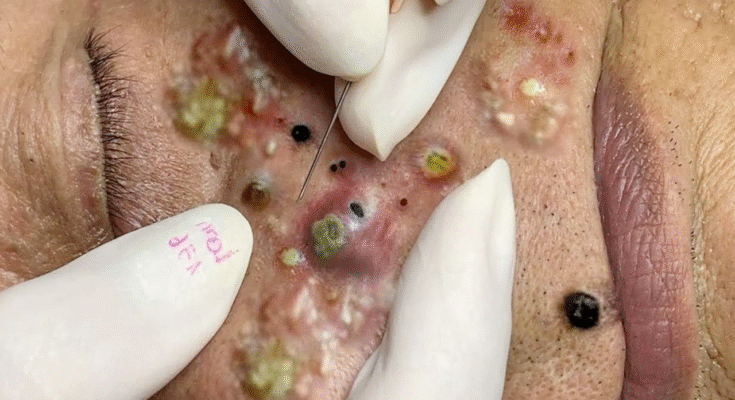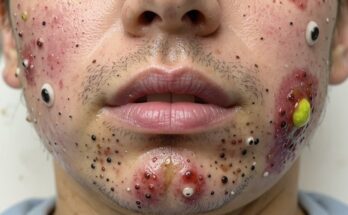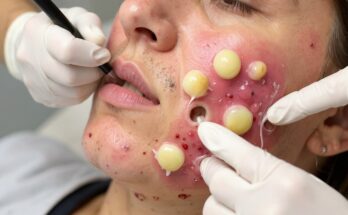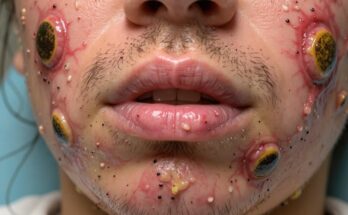Acne is one of the most common — and most misunderstood — skin conditions. Nearly everyone experiences it at some point, from teenage breakouts to stubborn adult acne. And while causes can range from hormones to lifestyle, one truth remains: what you put on your skin matters.
Choosing the right skincare ingredients can mean the difference between clear, glowing skin and endless frustration. But with so many products claiming to “fight acne,” how do you know what actually works?
This comprehensive guide takes you deep into the science of acne-fighting ingredients — explaining what they do, how they work, and which are best for your skin type. You’ll also learn how to combine them effectively and build a skincare routine that treats acne while maintaining a strong, healthy skin barrier.
Let’s dive in.
1. Understanding Acne and Why Ingredients Matter
Before we get into the ingredients themselves, it’s important to understand how acne forms and what’s happening beneath the surface.
1.1 What Causes Acne?
Acne is a multi-factorial condition — meaning several things cause it to appear and persist. The main four are:
-
Excess oil production (sebum): Overactive sebaceous glands create too much oil, clogging pores.
-
Clogged pores: Dead skin cells and sebum mix, forming comedones (whiteheads and blackheads).
-
Bacteria overgrowth: Cutibacterium acnes (formerly P. acnes) thrives in clogged pores, triggering inflammation.
-
Inflammation: The body’s immune response causes redness, swelling, and sometimes cysts.
Every acne treatment ingredient targets at least one of these mechanisms. That’s why understanding how an ingredient works helps you select products that fit your skin’s needs.
2. The Ultimate Acne-Fighting Ingredient List
Here are the most effective, research-backed ingredients that dermatologists recommend for preventing and treating acne.
2.1 Salicylic Acid (BHA)
What it is:
A beta hydroxy acid derived from willow bark. It’s oil-soluble, meaning it can penetrate deep into pores — a game-changer for acne-prone skin.
How it works:
-
Exfoliates inside pores: Dissolves the “glue” holding dead skin cells together.
-
Unclogs pores: Prevents whiteheads and blackheads.
-
Reduces inflammation: Chemically related to aspirin, it soothes irritation.
-
Controls oil: Regulates sebum production over time.
Best for:
-
Oily or combination skin
-
Blackheads, whiteheads, mild acne
How to use:
Start with low concentrations (0.5–2%) once daily or every other day. Found in cleansers, toners, and leave-on serums.
Pro tip:
Avoid combining with strong acids or retinoids in the same routine to reduce irritation.
2.2 Benzoyl Peroxide
What it is:
A time-tested antibacterial ingredient that targets acne-causing bacteria at the source.
How it works:
-
Kills bacteria: Oxygenates pores, destroying C. acnes (which thrives in oxygen-poor environments).
-
Prevents resistance: Bacteria don’t develop tolerance to it — unlike antibiotics.
-
Clears pores: Helps shed dead skin and oil.
-
Reduces inflammation: Calms redness and swelling.
Best for:
-
Moderate to severe acne
-
Inflammatory lesions (pimples, pustules, cysts)
How to use:
Use 2.5–5% concentrations (higher can irritate without extra benefit). Apply as a spot treatment or wash-off product once daily.
Pro tip:
It can bleach fabrics — use white towels and pillowcases!
2.3 Retinoids (Vitamin A Derivatives)
What they are:
Powerful derivatives of Vitamin A, including retinol, adapalene, tretinoin, and tazarotene.
How they work:
-
Boost cell turnover: Prevents dead skin buildup that clogs pores.
-
Normalizes follicular keratinization: Keeps pores clear and refined.
-
Reduces inflammation: Calms redness and swelling.
-
Fades acne scars: Over time, improves texture and tone.
Best for:
-
Comedonal acne (whiteheads and blackheads)
-
Post-acne scarring and uneven texture
How to use:
Start with over-the-counter adapalene 0.1% (Differin) 2–3 times a week at night, increasing frequency as tolerated.
Pro tip:
Always apply at night and follow with moisturizer. Retinoids increase sun sensitivity, so use sunscreen every morning.
2.4 Niacinamide (Vitamin B3)
What it is:
A multi-functional vitamin that’s both acne-fighting and barrier-repairing.
How it works:
-
Regulates sebum production — less oil, fewer clogged pores.
-
Reduces redness and inflammation.
-
Fades post-acne pigmentation.
-
Strengthens skin barrier, improving tolerance to other actives.
Best for:
-
All skin types, especially sensitive or combination skin
-
Inflammation, redness, and post-acne marks
How to use:
Niacinamide works well at 5–10% concentrations, morning or night, often layered under moisturizer or alongside other actives.
Pro tip:
It pairs beautifully with retinoids, salicylic acid, or azelaic acid for a balanced, non-irritating regimen.
2.5 Azelaic Acid
What it is:
A naturally occurring dicarboxylic acid found in grains like barley and wheat. It’s both an acne-fighter and a brightening agent.
How it works:
-
Antibacterial: Inhibits C. acnes growth.
-
Anti-inflammatory: Soothes redness and swelling.
-
Unclogs pores: Helps clear mild acne and comedones.
-
Brightens skin: Inhibits tyrosinase, reducing pigmentation and dark marks.
Best for:
-
Mild to moderate acne
-
Sensitive or rosacea-prone skin
-
PIH (post-inflammatory hyperpigmentation)
How to use:
Apply a 10–20% azelaic acid cream or gel once or twice daily.
Pro tip:
Gentle enough for daily use — excellent for pregnant or sensitive users who can’t tolerate retinoids.
2.6 Alpha Hydroxy Acids (AHAs)
What they are:
Water-soluble exfoliating acids like glycolic, lactic, and mandelic acids.
How they work:
-
Exfoliate surface layers: Removes dull, dead skin.
-
Stimulate collagen: Improves skin texture and scars.
-
Fade pigmentation: Brightens tone and smooths roughness.
Best for:
-
Dry or dull skin
-
Acne scars or discoloration
How to use:
Start with 5–10% glycolic or lactic acid products, 1–2 times weekly. Always pair with SPF.
Pro tip:
For darker skin tones, mandelic acid is a gentler AHA that helps fade hyperpigmentation without irritation.
2.7 Sulfur
What it is:
A natural mineral used for centuries to treat acne due to its antibacterial and oil-absorbing properties.
How it works:
-
Absorbs excess oil
-
Unclogs pores
-
Kills bacteria
-
Dries out active pimples quickly
Best for:
-
Oily and combination skin
-
Occasional breakouts
How to use:
Use sulfur masks or spot treatments (2–10%) once or twice a week.
Pro tip:
Modern formulations reduce sulfur’s characteristic “egg” smell while keeping full potency.
2.8 Zinc
What it is:
A mineral with anti-inflammatory, antioxidant, and oil-regulating properties.
How it works:
-
Regulates sebum production.
-
Reduces redness and irritation.
-
Supports healing of active blemishes.
Best for:
-
Red, inflamed acne
-
Hormonal acne
How to use:
Found in topical serums (zinc PCA) or taken as oral supplements under medical supervision.
Pro tip:
Zinc + Niacinamide = a powerful anti-inflammatory duo for calming active breakouts.
2.9 Tea Tree Oil
What it is:
A natural essential oil extracted from the Melaleuca alternifolia plant.
How it works:
-
Kills acne-causing bacteria naturally.
-
Reduces swelling and redness.
-
Dries out whiteheads.
Best for:
-
Mild, occasional acne
-
Natural skincare routines
How to use:
Look for 5% diluted formulations — never apply pure essential oil directly to skin.
Pro tip:
Combine with soothing ingredients like aloe vera or niacinamide to balance potential irritation.
2.10 Clay (Kaolin and Bentonite)
What it is:
Mineral-rich substances that absorb oil and impurities.
How it works:
-
Detoxifies pores.
-
Absorbs excess oil.
-
Soothes inflammation.
Best for:
-
Oily, congested, or combination skin
-
Blackheads and clogged pores
How to use:
Apply as a mask 1–2 times per week. Avoid leaving it on until fully dry (can over-dry skin).
3. Supporting Ingredients for Skin Barrier Health
Fighting acne is important — but maintaining the skin barrier is crucial. Overusing strong actives can lead to dryness, sensitivity, and more breakouts.
Barrier-loving ingredients:
-
Ceramides: Rebuild the skin’s lipid layer.
-
Hyaluronic Acid: Hydrates without clogging pores.
-
Squalane: Non-comedogenic oil for balance.
-
Panthenol: Soothes and strengthens barrier.
-
Centella Asiatica (Cica): Calms inflammation and speeds healing.
Pro tip:
If you’re using multiple acne-fighting actives, always follow with a calming, barrier-repairing moisturizer.
4. Ingredient Pairings: What Works and What Doesn’t
✅ Smart Combinations
| Combo | Why It Works |
|---|---|
| Niacinamide + Salicylic Acid | Reduces irritation and balances oil. |
| Retinoid + Niacinamide | Strengthens barrier and enhances results. |
| Vitamin C + Sunscreen | Boosts UV protection and brightens skin. |
| Azelaic Acid + Niacinamide | Targets acne and pigmentation gently. |
⚠️ Avoid These Combos
| Combo | Why to Avoid |
|---|---|
| Retinoids + AHAs/BHAs (same routine) | Too harsh; can irritate barrier. |
| Benzoyl Peroxide + Retinoids (same time) | Deactivates retinoids; alternate AM/PM. |
| Multiple exfoliating acids | Over-exfoliation risks redness and flaking. |
5. Building the Perfect Acne-Fighting Routine
Here’s how to structure your daily routine using powerhouse ingredients effectively and safely.
Morning Routine
-
Cleanser: Gentle or salicylic acid-based.
-
Treatment Serum: Niacinamide, Vitamin C, or Azelaic Acid.
-
Moisturizer: Lightweight, non-comedogenic formula.
-
Sunscreen: Broad-spectrum SPF 30–50 (every single day).
Evening Routine
-
Cleanser: Gentle or BHA-based.
-
Treatment: Retinoid or Benzoyl Peroxide (alternate nights).
-
Moisturizer: Barrier-repair cream with ceramides and panthenol.
Weekly Extras
-
Clay Mask: 1–2 times weekly for oil control.
-
AHA Exfoliant: Once weekly for brightness.
-
Hydrating Sheet Mask: To soothe skin and prevent dryness.
6. Acne by Skin Type: Choosing the Right Ingredients
| Skin Type | Best Ingredients | Avoid |
|---|---|---|
| Oily | Salicylic Acid, Niacinamide, Zinc, Clay | Heavy oils, coconut oil |
| Dry | Lactic Acid, Retinoids (low dose), Ceramides | Alcohol-heavy toners |
| Combination | Azelaic Acid, Niacinamide, BHAs | Overlapping actives |
| Sensitive | Azelaic Acid, Cica, Panthenol | Benzoyl Peroxide (high %, unbuffered AHAs) |
7. Common Mistakes When Using Acne Ingredients
-
Starting too many actives at once → Barrier damage.
-
Skipping moisturizer → Increases oil production.
-
Not using sunscreen → Pigmentation and irritation worsen.
-
Over-cleansing → Strips protective oils.
-
Giving up too soon → Most acne actives need 8–12 weeks for results.
8. When to See a Dermatologist
If you’ve been using acne-fighting ingredients for 3–4 months with little improvement, or your acne is severe and cystic, it’s time for professional help.
Dermatologists can prescribe:
-
Oral retinoids (isotretinoin)
-
Hormonal therapies (spironolactone, birth control)
-
Stronger topical retinoids or antibiotics
-
In-office treatments like chemical peels, light therapy, or microneedling.
9. The Long-Term Strategy: Clear Skin Maintenance
Once your acne is under control:
-
Maintain with gentle exfoliation and nightly retinoids.
-
Keep your skin barrier healthy.
-
Continue using sunscreen daily.
-
Avoid comedogenic makeup and heavy skincare.
Acne prevention is a lifelong process, not a one-time fix.
10. The Bottom Line
The path to clear skin isn’t about trying every product on the shelf — it’s about understanding ingredients, using them correctly, and being consistent.
The real acne-fighting powerhouses — salicylic acid, benzoyl peroxide, retinoids, niacinamide, azelaic acid, and supportive hydrators — are proven, safe, and effective.
When used strategically and patiently, they can dramatically transform acne-prone skin, reduce scarring, and restore your confidence.



